It was a plane which would likely never have been built had it not been for the Second World War.
Released in 1946 after a successful test flight a year earlier, the Bristol Type 170 Freighter was a product of the rapid advance of technological development ushered in by the 1939-1945 conflict.
Though it did not end up being used in the war, it had originally been designed for military use in the Far East campaign against Japan.
The impressive creation – which had a wing span of 108feet – could carry both passengers and vehicles over short distances and, fortunately for UK maker the Bristol Aeroplane Company, it proved very popular both domestically and abroad for commercial and cargo flights.
In 1956, Prince Philip flew on a Bristol Freighter which was exporting two sports cars to France.
A contemporary Daily Mail news report revealed how, after watching the cars get loaded into the plane at Lydd airport in Kent, the Duke of Edinburgh, who had a pilot’s licence, climbed into the co-pilot’s seat and took control for part of the journey.
The plane’s success saw thousands of cross-channel flights carried out in the late 1940s and early 1950s.
Until production was ceased in 1958, a total of 214 aircraft were built, including both the original version and subsequent variants, such as the larger Superfreighter, which could carry 20 passengers and three cars at any one time.
The plane was also used by foreign air forces, including those of Argentina, Burma, Canada, New Zealand and Pakistan.
However, the plane’s use in the UK declined when main operator Silver City was taken over by a rival in 1962 after increasing competition from cheaper roll-on/roll-off ferries caused financial difficulties.

It was a plane which would likely never have been built had it not been for the Second World War. Released in 1946 after a successful test flight a year earlier, the Bristol Type 170 Freighter was a product of the rapid advance of technological development ushered in by the 1939-1945 conflict. Above: A car being loaded onto one of the planes in 1960 at Speke Airport in Liverpool

Though it did not end up being used in the war, it had originally been designed for military use in the Far East campaign against Japan. The impressive creation – which had a wing span of 108feet – could carry both passengers and vehicles over short distances and, fortunately for UK maker the Bristol Aeroplane Company, it proved very popular both domestically and abroad. Above: A Dan-Air Bristol Freighter operating a cargo service at Manchester Airport in 1964
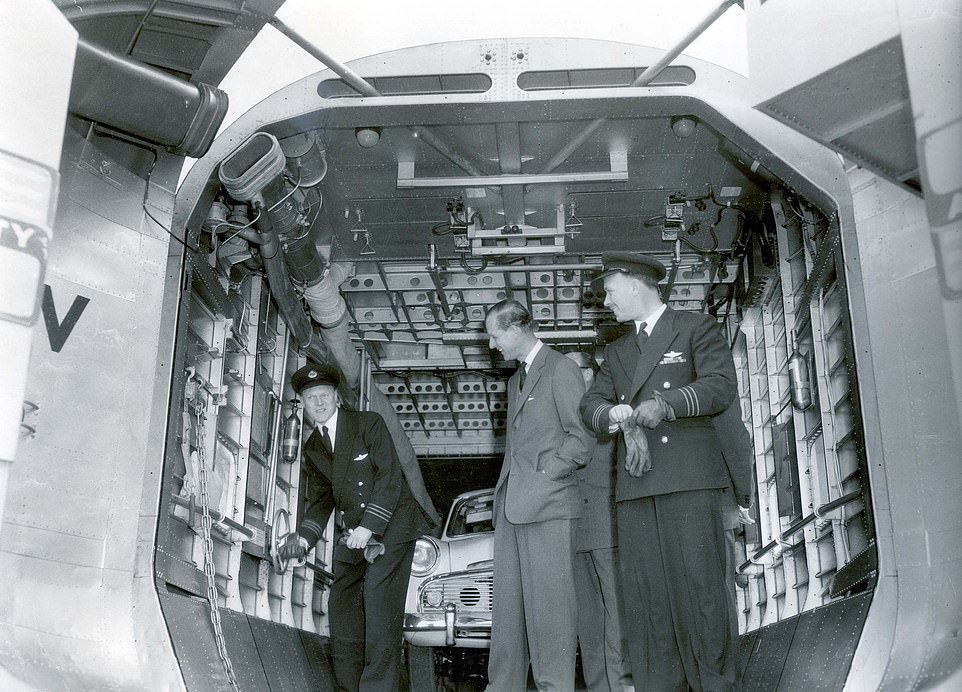
In 1956, Prince Philip flew on a plane which was exporting two sports cars to France. Above: The Duke smiles as he talks to two staff members at Lydd Airport in Kent. He later climbed into the co-pilot’s seat for the trip across the Channel
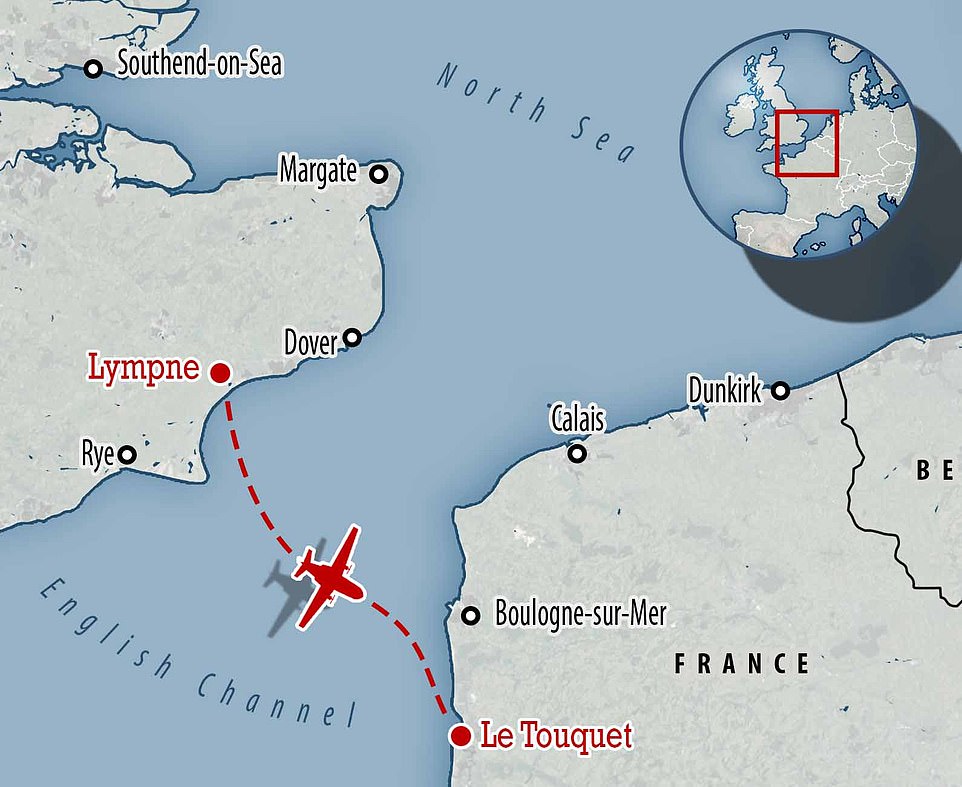
The first flight with a car took place in July 1948, between Lympne in Kent and Le Touquet, near Calais in northern France

The Daily Mail’s 1956 report about Prince Philip’s jaunt in a Bristol Freighter said: ‘After the plane had crossed the coast the Duke took over controls from pilot Captain Dave Flett, dropped to 1,000ft, then crossed the Channel at 160 miles per hour
The plane was instantly recognisable thanks to its rounded nose doors ahead of a ‘boxy’ fuselage.
The first flight with a car took place in July 1948, between Lympne in Kent and Le Touquet, near Calais in northern France.
In a British Pathe video of the event, car was seen being driven by an airport employee up a ramp into the back of the plane, before its rear doors were closed.
The film’s narrator said that it was a ‘tricky job where luggage space is calculated to the square inch.’
The 48-mile journey is said to have taken just 25 minutes, rather than the several hours that the same journey would have taken by boat.
After the successful flight, the cross-channel route blossomed. By 1954, main operating airline Silver City averaged an incredible 2,970 landings and take-offs per aircraft within the fleet.
This worked out at a little more than eight trips per day on every day of that year.
As well as the popular routes to France, the plane was also used to take paying passengers to the Channel Islands.
The Superfreighter, which was first flown on January 16, 1953, had a longer nose and increased fin area, along with a larger cargo bay.
This allowed for capacity to increase to a maximum of three 14ft-long cars and 20 passengers.
The Daily Mail’s 1956 report about Prince Philip’s jaunt in a Bristol Freighter said: ‘After the plane had crossed the coast the Duke took over controls from pilot Captain Dave Flett, dropped to 1,000ft, then crossed the Channel at 160 miles per hour.
‘As the Bristol crossed the French coast Captain Flett took over. He explained later: “The Duke is a jolly good pilot, but he had never flown this type of plane before, so it was decided that I should land it.
“There was a pretty turbulent wind,”‘ he added.
The report then said that a French guard of honour ‘smacked their rifles’ as the cars were driven off to their buyers.
It said he ‘smiled and waved’ at a group of ‘cheering French women’ who were behind a barrier.’
It is not clear from the report if the cars being sold had belonged to the Duke.
By the early 1960s, Silver City was suffering heavy financial losses and was taken over by British United Airways’s parent company Air Holdings.
BUA were the operator of a rival air ferry service and their takeover removed the only remaining independent competitor in the business.
Further heavy losses suffered by the Silver City brand saw its name retired and its aircraft were repainted in BUA colours or retired entirely.

A 1945 advert for the plane said: ‘The “Bristol” Freighter is here and it is now being demonstrated in Canada. ‘A new type of aircraft ideal for bush flying, air freight or passenger service.’ ‘Power for power it has more cargo space and carrying capacity than any other cargo aircraft.’ It said the plane was built to carry ‘large payloads at low cost’ and added that the creation was ‘literally a freight car with wings’

A 1946 advert for the then newly-released Bristol Freighter said it was set to go on several demonstration tours across North and South America
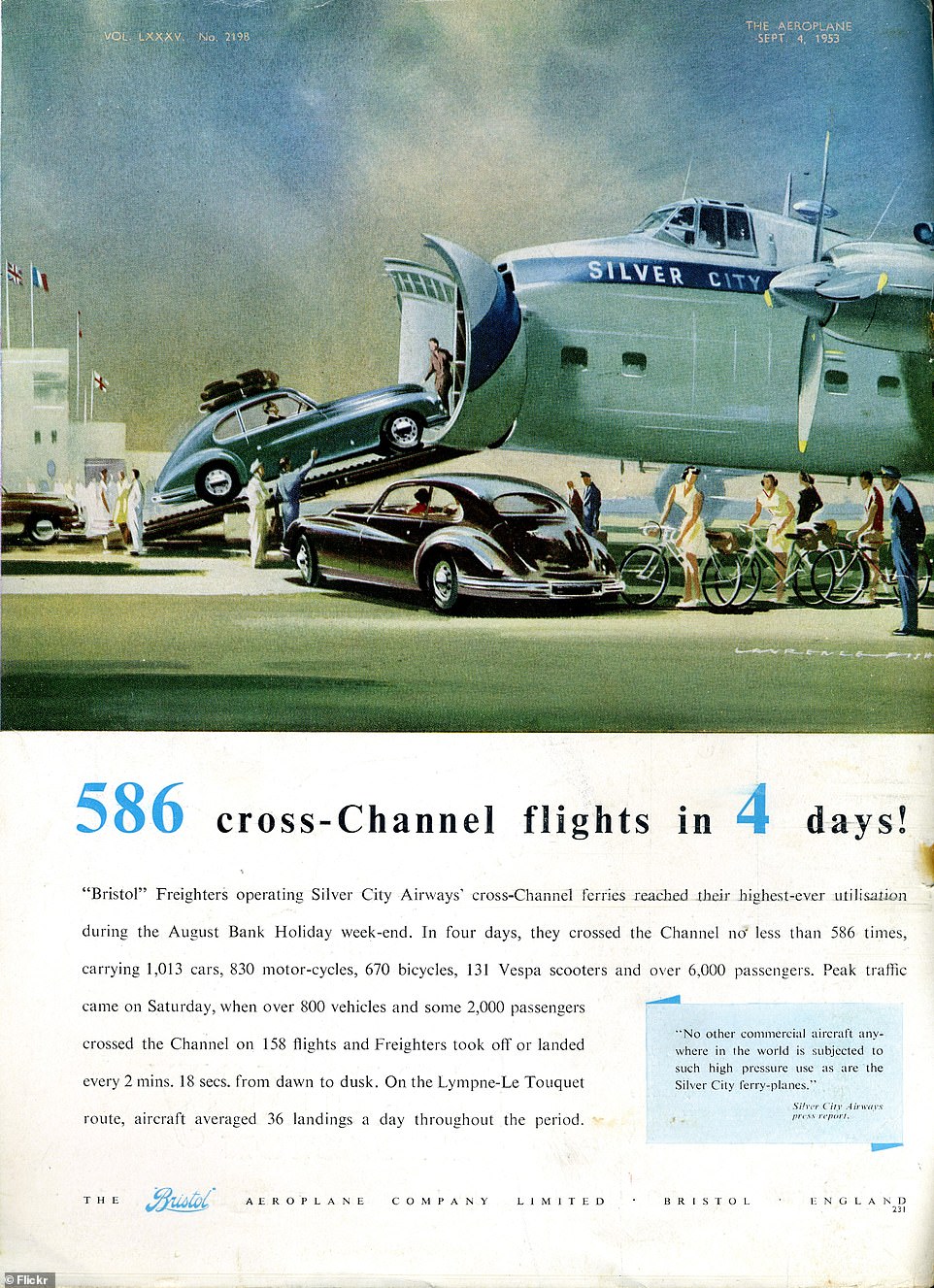
A Silver City Airways advert for the Bristol Freighter on the back of a September 1953 issue of ‘The Aeroplane’ magazine

Until production was ceased in 1958, a total of 214 aircraft were built, including both the original version and subsequent variants, such as the larger Superfreighter (above), which could carry 20 passengers and three cars at any one time
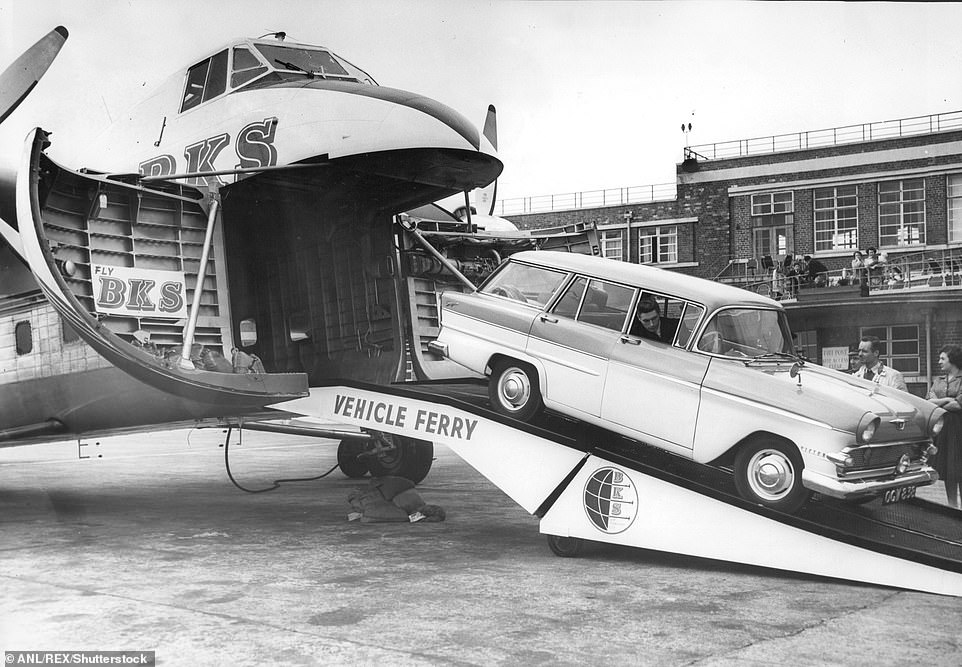
The plane was instantly recognisable thanks to its rounded nose doors ahead of a ‘boxy’ fuselage. Above: A car being loaded on to one of the planes for a flight to Dublin in 1960
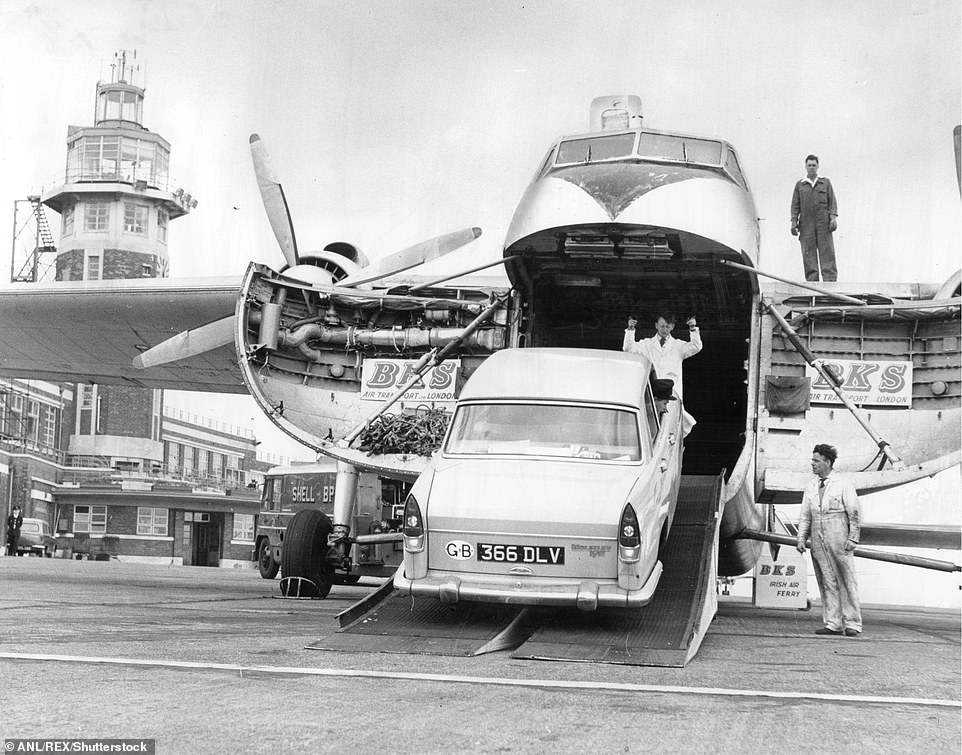
By 1954, main operating airline Silver City averaged an incredible 2,970 landings and take-offs per aircraft within the fleet. This worked out at a little more than eight trips per day on every day of that year
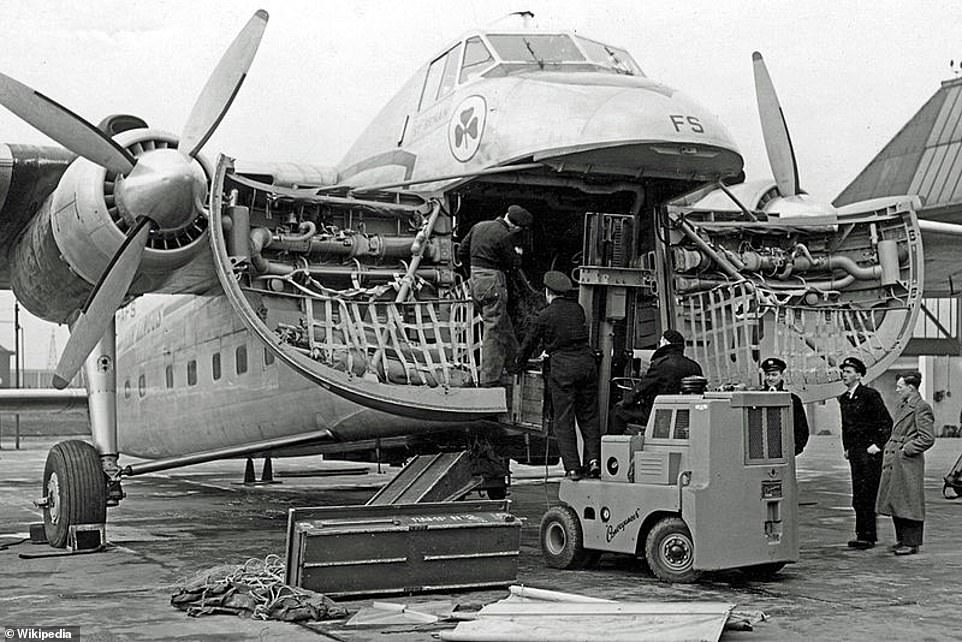
Above: A Bristol Freighter operated by Aer Lingus being loaded through the clamshell nose doors in 1952

A Bristol Freighter in now-defunct Norcanair livery at the Western Canada Aviation Museum in Winnipeg, Canada, in 2007

A retired Bristol Freighter is seen in New Zealand. The country, which had used the planes as part of its air force, retired them in the 1970s
As a result of the emergence of high-capacity roll-on/roll-off ferries, the air service was now not financially viable.
It meant that aircraft manufacturers were not interested in producing replacements for the now-ageing Bristol Freighters and Superfreighters, which were suffering from wing fatigue.
New Zealand, which had used the planes as part of its air force, retired them in the 1970s. In nearby Australia, a freighter which had been in service went on to become a museum exhibit after 1978.
The plane’s final flight took place in 2004, when the last freighter in service was flown to the Reynolds-Alberta Museum, in Canada, to be put on display.
A 1945 advert for the plane said: ‘The “Bristol” Freighter is here and it is now being demonstrated in Canada.
‘A new type of aircraft ideal for bush flying, air freight or passenger service.’
‘Power for power it has more cargo space and carrying capacity than any other cargo aircraft.’
It said the plane was built to carry ‘large payloads at low cost’ and added that the creation was ‘literally a freight car with wings’.
Source link : https://www.dailymail.co.uk/news/article-9973809/How-Bristol-Freighter-planes-flew-drivers-cars-France-WWII.html












